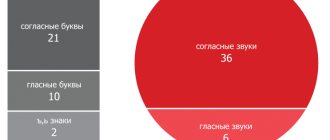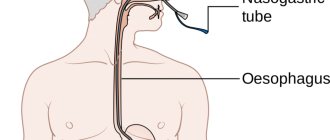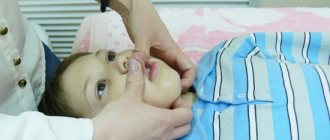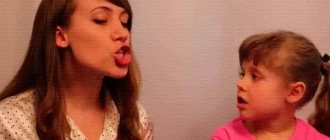Article:
Objectives :
Educational:
- clarify ideas about the sounds and letters “T” and “D”;
- improve and consolidate the ability and skills of differentiation
- sounds and letters “T” and “D” in syllables, words, phrases and sentences;
- enrich vocabulary
Educational:
- develop phonemic perception, skills of sound-letter and syllabic analysis and synthesis;
- develop visual and auditory attention, logical thinking and memory;
- develop spatial and visual concepts;
- develop gross and fine motor skills
Educational:
- foster activity and independence of students in the classroom;
- instill self-control over speech in children;
- foster a sense of camaraderie and goodwill;
- develop interest in speech therapy classes.
Equipment:
Doll “Znayka”, travel map for each student, letter-symbols “T” and “D”, watercolor paints, blank letters, stars, tape recorder, disc by Antonio Vivaldi - “The Seasons”, disc - classic in nature “Beethoven and the Forest” cool”, computer, projector, object pictures, 6 sets with puzzles for modeling, blanks in the form of “snowflakes”, “Christmas trees”, “cars”, “Clever” and “Clever” badges.
Progress of the lesson
I. Organizational moment.
1. Creating an emotionally positive background for the lesson (in a circle on the carpet).
Guys! Let's stand in a circle, extend our palms to our neighbors and share the warmth with each other. Let's smile and wish each other good luck!
Today you will have an exciting winter trip to the station “Umnikov and Umnitsy” together with the smart fairy-tale hero, Znayka.
To do this, we need to properly prepare for this journey.
– What date is today? What day of the week? What season? 1. Game “Snowball”, children name the signs of a winter day. (What kind of winter day? Children’s answers: snowy, frosty, cold, white, short, gloomy.)
– Guys, name the objects, then highlight the first sound in the words and you will find out what type of transport we will go on (Slide 1 showing object pictures - coat, monkey, raccoon, umbrella, woodpecker.)
- Well done, we're going on a fun train!
2. Rhythmic warm-up “Train”. The speech therapist invites students to divide into pairs. Children clap their hands with a gradual increase in speed.
The train started moving And now the train is picking up speed.
Speech therapist: - So, our train is ready for departure, all that remains is to correctly place all the passengers in their cars. (From the proposed pictures: board, notebook, calculator, felt-tip pens, pencil, computer, the 1st pair selects only those whose name consists of one syllable, the 2nd pair selects pictures with 2 syllables, the 3rd pair selects pictures from 3 syllables – )
II. Announcement of the topic and objectives of the lesson
Speech therapist: - Guys, guess the riddles, determine the first sound in the riddles.
I’m lying in my school bag, I’ll tell you how you study. (Diary.)
Now I'm in a cage, now in a line, You can write on me. You can also draw. What am I? (Notebook.)
Speech therapist: - What do you think we will do with the letters “T” and “D” during our journey (pronounce correctly, distinguish by spelling and pronunciation, designate with letters, find these sounds in syllables, words and sentences (Slide 2) .
III. The main part of the lesson.
1 . Speech therapist: - We arrived with you at the Bukvarik station (Slide 3). What sound is it talking about?
With the tongue, the front edge, we hit the upper gums.
The sound is short, the sound is explosive, the sound is voiceless, dull.
(Children pronounce the sound [T], give it a description, prove deafness with various control techniques: fingers on the vocal cords, ears covered with palms.) Znayka gives stars to those children who answered correctly. Similarly: working with sound [D] after reading lines.
We'll hit the gum with our tongue, we'll add a ringing voice.
Similarities: both sounds are consonants, Difference: voiced, deaf.
– What do the letters “D”–“T” look like? (Children’s answers.) The speech therapist shows pictures (Slide 4, 5) and reads the lines.
The hammer knocks: Knock, knock! I am the letter “T”’s best friend!
There stands blowing smoke, the letter D is a chimney.
2. Game “Scouts”.
Speech therapist: – We replaced the letter “D” with the number – 2, and the letter “T” with the number – 1.
Unscramble the syllables by replacing the numbers with the corresponding letter. (Slide 6) Write down the answers on “snowflakes”.
– Which of them are not words? (Awarding stars.)
3. Breathing exercises.
Speech therapist: - How should we speak? (Clearly, distinctly, understandable to everyone.) Let’s do breathing exercises. The “breathing cloud” will help us (Slide 7).
Performing exercises:
IP: standing, arms down. We take a slow breath through the nose, inflate the tummy, hands in front of the chest. Exhale slowly through your mouth, while simultaneously drawing a circle symmetrically with both hands. We try to distribute the air over the entire circle. We repeat three times. Now let's draw squares and triangles (three times each). Let's work on the strength of exhalation. Exercise “candle”. Inhale through the nose, three short strong exhalations onto the fingers, representing a burning candle. We repeat three times.
4. Speech therapist: - Znayka invites us to go to the next station “Gramoteyka” (Slide 8).
Isolating D–T in words from pictures (Slide 9).
– Attention to the screen “Now you will see pictures there, and show the letter “D” or “T” that you will write in this word. Use the letters D-T that you colored.
- What is this? What letter will we write in this word? What account will we write it down? (Shovel, star, telephone, house, candy, sofa.)
5. Game “Find and Read”.
- Guys, find the words in the table and read them. Name words that contain the sounds “T”–“D” (snowmobile and ice, Slide 10).
6. Physical education minute “Locomotive”.
| The engine goes, goes: Chuh-chukh-chukh, chuk-chukh-chukh. He takes the kids home: Chukh-chukh-chukh, chuk-chukh-chukh. Past the pines and rowan trees: Chuh-chukh-chukh, chuh-chukh-chukh. Past the fir trees and aspen trees: Chuh-chukh-chukh, chuk-chukh-chukh. Stop on the lawn: Chug-chug-chug, chug-chug-chug. We'll jump like bunnies: One-two-three, one-two-three. Let's play, have fun and return to the carriages. Past the maples and birches: Chuh-chukh-chukh, chuh-chukh-chukh, The little train rides again: Chukh-chukh-chukh, chuh-chukh-chukh. | Rotate both hands alternately at the shoulder and elbow joints; “fist-rib-palm” for counting; repeat the “train” movement; “fist-rib-palm” 2 times; “little train”, we speed up the pace; “fist-rib-palm” 2 times; “train” at a fast pace; “fist-rib-palm” 2 times, fast pace; slowly spread your arms to the sides, stretching; “fist-rib-palm” 2 times, slow down the pace; hands on the belt, jumping on two legs; jumping alternately on the left and right leg; jumping with turns left and right; marching in place; locomotive movement; “fist-rib-palm” 2 times; “locomotive”; “fist-rib-palm” 2 times, speed up the pace. |
7. Speech therapist: - Guys, we stopped at the final station of “Clever Men and Clever Girls” ( slide No. 11 ). Znayka received an envelope with an assignment for us.
8. Make up a phrase. (Slide 12)
Speech therapist: – Read the words of the first column. What letters are missing in the words? (letters “T” - “D”), then the words of the second column. – Connect the words from the first column with the words from the second column so that you get phrases (doing the work on handouts in the form of “Christmas trees”). Checking the task.
9. – Make up sentences using words and pictures. (Slide 13).
IV. Summary of the lesson.
Speech therapist: - Guys, our journey ends. Tell Znayka about your mood, your impressions of our journey, what sounds we heard today. What tasks did you like? Finally, I will ask everyone to pronounce only the letters, form a word and read (Slide 14). The final word is well done!
- Well done! Now close your eyes and listen to the words that Znayka wants to tell you: “I really liked the way you talked about your mood. I'm glad you completed all the tasks. I want to wish you to always be kind and friendly, so that you always have a cheerful, joyful mood! Goodbye! See you again!
Techniques for producing sounds T D
The classic techniques of speech therapy work are the preparatory stage and sound production, which can also be actively used in home exercises. If you choose the right exercises, it will not be difficult for parents to cope with their child’s speech disorders.
Important: before teaching a child the correct articulation of the sound T ( D ), the adult must himself practice the position of the lips and tongue in front of the mirror: the lips take the position of the vowel that follows T (ta - ta - ta); the tongue is fixed in the upper teeth; the palate is raised. In addition, articulatory gymnastics must also be previously rehearsed by an adult.
Preparatory stage
Speech therapists insist that if the baby’s tongue is not strong enough to make sounds, it is necessary to first strengthen the muscles of the tongue and lips. Therefore, the preparatory stage necessarily includes articulation gymnastics. Speech therapy massage exercises will help prepare the speech apparatus for it::
- An adult, using a mirror, teaches the preschooler to take the correct position of the lips and tongue, showing the differences in pronunciation, for example, T (tip of the tongue) and K (tail of the tongue): “The cake is being eaten,” “Drops are dripping.”
- Making the T requires a sharp and strong exhalation. Therefore, it is necessary to develop the ability to exhale correctly. You can use the following exercises: “Soap bubbles”, “Balloon”, “Flying snowflakes (from a napkin or cotton balls)”.
- Then follows articulation gymnastics:
- “Wide smile” – connect your teeth, stretch your lips wide and hold this position for up to 7 seconds.
- “Tick-tock clock” - the tongue quickly moves left and right along the upper lip.
- “The tongue does not obey” - say five-five-five, tapping your upper lip on your tongue, gradually differentiating (distinguishing) the sounds P T.
- “Tongue - spatula” - relax the tongue, making it wide, place it on the relaxed lower lip.
Important: we must try to make it interesting for the child to complete rather monotonous preparatory tasks. To do this, it is necessary to introduce new articulatory gymnastics exercises, which can be borrowed from speech therapy practice, at each home lesson.
Staging sounds
How to install sound at home? Experts offer several ways to set sound; a parent can try all of them and choose the one that is more accessible and understandable to the baby.
- Setting T by imitation: an adult invites a preschool child to repeat first the syllables, and then the words; it is advisable to start with the syllable “ta”. For example: ta-ta-ta, ta-you-to-tu, you-you-you, you-ta-to-tu, to-to-to, to-tu-ta-you. Then the transition to words - pure words: ta-ta-ta, ta-ta-ta, such beauty; you-you-you, you-you-you, gave us flowers; tu-tu-tu, tu-tu-tu, we clean up; so-and-so, so-and-so, I put on my coat. A creative approach to speech activities will allow parents to independently compose similar phrases in sound, involving children in creativity.
- Interdental method: an adult shows the child the position of the tongue (the tongue is pressed between the lips, in this position you need to exhale strongly until you hear a sound, then place the tongue behind the teeth). You can teach how to control your exhalation by playing a “fence” for air by placing your palm in front of your mouth. Or arrange a game of “ball” (a cotton ball is driven into an improvised goal with a stream of air).
- Speech therapists use the method of setting T from the sound P. The child repeats pa-pa-pa, placing the wide tip of the tongue on the lower lip, then, smiling broadly, pronounces P , resulting in T.
- When setting D , the work is identical, only when exhaling the voice is added.
Automation of sounds T D
When the sounds T D are delivered (correct articulation has appeared) and the child learns to pronounce them, the next stage begins - automation (practice of the skill). It is important to achieve fluent pronunciation here. Since this is new for a preschooler, it means a lot of training is required. Speech therapists recommend introducing the practiced skill gradually: first through syllables, then words, then sentences. Articulation exercises, games based on poetry, stories, riddles will help well in this work, which will also maintain interest in the classes. At the same time, do not forget that every home lesson must begin with articulatory gymnastics.
Important: parents need to make every effort to ensure that the incorrect pronunciation of T D disappears from the child’s speech as quickly as possible. It should be taken into account that new material is introduced only after the previous one has been mastered.
What can an adult do to keep the child interested in activities and at the same time repeat monotonous actions over and over again? Gaming techniques will help, with the help of which syllables are practiced, for example: ta-ta-ta, yes-da-da, to-to, do-do-do, ta-you-to-tu, at-at-at, yes-dy-du, yt-yt-yt, ud-ud-ud. Plots can be very diverse:
- Let's teach the doll to brush its teeth, show it what articulation gymnastics is: “let's brush the teeth” (various movements of the tongue on the teeth from the outside and inside, up and down, left and right).
- Let's sing a song to the toys: “tra-ta-ta, tra-ta-ta, we are taking a cat with us”;
- Play the drum for the bear: tram-ta-ta-tam; on a dog pipe: doo-doo-doo.
- I start speaking, and you finish (the adult pronounces part of the word, which must end in a syllable with the sounds T D ): flowers, beauty, candy, mast, coat, bouquet; bicycles, sneakers, beards.
- Hello, little finger! (the thumb is put forward, and each finger in turn “greets it” with the syllables: ta, to, tu, you; yes, do, du, dy).
After the preschooler has automated sounds, the work becomes more complicated, the pronunciation of sounds is fixed in words.
Exercise “Collecting beads”
An effective exercise on automating the sound T with older preschoolers. An adult invites the preschooler to collect unusual beads, having previously agreed which syllable should follow which. For example, there may be such a sequence: that - that - you - that - that - that. Work with the sound d is carried out in a similar way. At first, you can rely on visual aids (colored beads, circles of colored paper, pencils). Subsequently, the visualization is removed, and the child acts from memory.
Exercise “Come up with words with the sounds T D”
Invite the child to repeat after the adult words with the sounds T D at the beginning, middle, and end of the word. For example, an adult starts with a more understandable syllable ta : ta kidneys, ta chka, ta reel; The baby continues: ta NK, ta Buret, ta Nets, ta Xi. Then he moves to another position T D : cat , cock , roll , leaf ; sala t , play t , collect t , bark t , help t . Or daughter , yes , day , gifts , soldier ( voice emphasis on the highlighted one). If at first it is difficult for a preschooler to continue his vocabulary, you can work with pictures. The work with the syllables you dy : you qua, hole , you , dy m; then to : then por, then mouth, then thick, kind , then chka, dochka ; tu du : tu chka, tu loop, ra du ga, du ga. It is better to prepare the vocabulary in advance. An even more interesting automation exercise will take place with a ball. The adult throws the ball to the child with his word, the child responds with his own.
Exercise “Sound t and sound d in a sentence”
Similar work is done with sentences; the preschooler repeats after the adult, emphasizing T D :
- Tanya and Tom are traveling on a tram.
- Trofim is riding in a taxi.
- The plane is flying.
- Aunt Tonya is planting flowers.
- Dima and Tolya are skating on the skating rink.
- Dasha and Denis shared the melon.
- Children go to kindergarten.
In order for a preschooler to be able to independently compose a sentence, plot pictures are used. It is necessary to ensure that all words of the sentence have a sound that is automated ( T D ).
Nursery rhymes, pure sayings for automating sounds etc.
To make it easy for parents to choose an artistic series for practicing the sounds of T D, you can use speech therapy selections or come up with pure sounding phrases together with your children. For example, the parent starts with syllables, and the child then rhymes the sentence:
- Ta-ta-ta, ta-ta-ta, (they saw a whale in the sea ) .
- Tu - tu - tu, tu - tu - tu, (let's pour some milk into it ).
- Yes - yes - yes, yes - yes - yes, (splashed all over with water ) .
- water in the glass ).
- Yes - yes - yes, yes - yes - yes, (don't go there ) .
- doo , (go there anyway ).
A lot of nursery rhymes can be found on children's websites or in children's books. Their main task is to automate the sound T ( D ), its correct pronunciation, for example:
Shadow, Shadow, Shadow, above the city there is a fence. The animals sat on the fence and boasted all day long. The fox boasted: I am beautiful to the whole world! The bunny boasted: Go, catch up!
Pull the canvases, the canvases are simple. Pull, Pull, Pull, Across, across.
We know, we know: Yes-Yes-Yes! Water is hiding in the tap! Come out, water! We came to wash up!
LaDushki, LaDushki, Let's bake pancakes. We'll put it on the window. Let's leave it to cool. Let's wait a little, Let's give pancakes to everyone.
Differentiation of sounds D T
An important stage in speech therapy work is the differentiation of sounds (distinguishing similar sounds, T D, D D, T T). This stage is carried out in parallel with automation and is necessary in order to compare sounds (soft and hard) and practice pronunciation. You can teach a preschooler new special techniques for distinguishing sounds: a hand is applied to the throat while sounding, the sound is determined ( D - voiced, voiced; T - deaf, without a voice). For differentiation, you can use already known techniques: syllables, words, sentences in exercises, games, sayings, nursery rhymes.
Differentiation of sounds T ТТ in the exercise “Compare sounds in guesses”
An adult asks the child to guess riddles, and then asks if the sound of T in all the riddles? The main thing is to make it possible to understand the difference in the pronunciation of the sounds T (hard) T (soft).
Round, not a month, yellow, not butter, Sweet, not sugar, with a tail, not a mouse ( you kwa).
He bows, bows, when he comes home he will stretch out ( then ).
A block froze over the water, and she dreams of fish for lunch. There are fins and too lazy to swim, the fish will be eaten by another ( seal laziness).
Exercise “Correct phrasing”
The goal is to teach how to pronounce and distinguish DY .
Grandfather Dodon played the pipe, Grandfather hit Danka with the pipe.
A woodpecker is chiseling a tree, Day after day crushes the bark.
Game "Come up with a proposal"
To establish and consolidate the pronunciation of T D , adults can teach children to come up with beautiful sentences while relying on verbal helpers. Then determine which words have hard T D and which have soft Т Дь:
Denis - telephone (Denis was given a telephone); Home is a cat (Our cat doesn’t walk, he’s at home); Tanya - melon (Tanya loves melon); Tyoma is a pipe (Tyoma learns to play the pipe); Dusya - pictures (Dusya loves to look at pictures);
Important: parents should understand that home exercises for correct pronunciation consist of developing the skill of pronouncing the sounds of their native language. This process is long, systematic, and requires patience and persistent training in automation and sound differentiation. A thoughtful selection of articulatory gymnastics, exercises, games, and verbal material will help to achieve good results in the development of competent, beautiful speech in preschool children.




